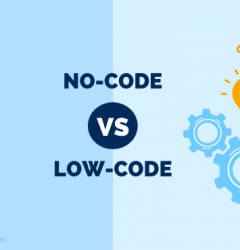10 Aug

This article was first published on Customer Think.
The last ten years have seen a new wave of business transformation fuelled by digital technologies that encourage software engineering and development innovation. Companies are proactively investing in advanced technologies and strategic models to innovate their business value proposition, brand vision and mission, process and system capabilities, and core offerings. Technology transformation is no longer an option; it is a must-do for ensuring long-term viability and accelerating the next big leap in the global marketplace.
At its most fundamental level, the failure of digitalization is due to a cultural disconnect. CIOs and other key decision-makers aren’t fully prepared to deal with the organization’s massive technological changes. Rapid digitalization fails due to a lack of a company-wide strategy and the cultural shifts required to keep the transformation going. This is where no-code platforms come to the rescue.
Before commencing any digital transformation initiative, it is essential that key stakeholders are well-informed regarding the benefits of no-code platforms and how no-code tools can simplify their roles.
Stakeholder 1 – The CEO
Rationalized IT spend
A significant portion of revenue allocation goes towards hiring specialized talent to build cutting-edge applications. But most of the technological resources end up troubleshooting technical glitches and doing regular maintenance work. No-code significantly reduces IT costs by facilitating citizen development.
High-value projects
No-code frees up highly skilled engineers and allows them to focus on innovation programs having greater strategic significance. This creates a pool of IT specialists who can take up high-value projects instead of building basic workflow applications.
Accelerated time to market
This can positively impact the throughput capabilities of the technology team.
Culture of innovation
Employees can be creative with technology and build their own custom applications using no-code platforms. This can help CEOs establish a workforce that can think on its feet and deliver independently, and as a result, sparking a culture of innovation across the organization
Also read: No-Code: A Quick & Agile technology solution for Business Leaders
Stakeholder 2 – The CIO
Inclusive workforce
As no-code platforms are easy to work with and require only a few weeks of training, CIOs can widen their pool of qualified candidates to build enterprise-grade applications. This pool can have business analysts, sales and marketing specialists, or strategists, and therefore, application development can become more inclusive.
Better collaboration between business and IT teams
No-code enabled citizen development bridges the gap between business users and IT teams. Using the intuitive and visual interface of no-code platforms, business users can participate more actively in the development process and curtail their dependence on IT personnel. On the other hand, IT teams can support business users in the selection of no-code platforms, maintenance or no-code applications, integration of third-party solutions, and much more.
Negligible shadow IT
Under citizen development, business users have the freedom to leverage no-code platforms, but at the same time, their roles, responsibilities, and permissions are defined by IT through a governance model. This way, no application is funded or built without the prior knowledge of IT teams.
Enterprise-grade data security and privacy
One of the top priorities of CIOs is the security and confidentiality of data. As mentioned above, no-code development (citizen development) ensures that IT has complete control over data management and access permissions. It gives IT teams the freedom to commission and decommission apps from a single centralized portal. If a team member switches roles or leaves the company, IT can revoke their access and prevent potential data tampering. Moreover, no-code platforms have built-in features that provide an extra layer of security.

Stakeholder 3 – The CFO
Enhanced productivity
No-code leverages both technical and non-technical skill sets to achieve a common goal of automating enterprise processes. Irrespective of their work experience, each resource can contribute by handling different aspects of application development. The result – better productivity across the organization
Better employee retention
The visual interface of no-code allows business users to be creative with technology and have fun along the way. On the other hand, programmers can focus on high value and rewarding tasks instead of everyday troubleshooting. This creates a happy workforce, improves employee retention, and reduces hiring costs.
Cost-Saving due to automation and reduced maintenance costs
Manual processes are vulnerable to errors and inefficiencies, translating into financial losses for the company. No-code platforms eliminate such losses by automating paper-based processes.
IT organizations invest significantly in updating legacy applications instead of driving digital transformation and contributing to more significant strategic objectives. In other words, their technical debt keeps increasing, which can reduce the productivity of the employees and drain the IT budget very quickly. IT budgets can be significantly rationalized if these legacy applications are migrated to no-code tools.
Also read: Breaking down the benefits of No-Code for CEO, CIO, CISO, CFO, and Business Leaders
Stakeholder 4 – Enterprise Architects
Better Time to Value
Traditionally, coding even the most basic iteration of a product takes a lot of time and cross-functional coordination, which can significantly increase time-to-market. No-code can instead help enterprise architects build minimum viable products, take constant user feedback, and do live customizations according to customers’ requirements. This reduces development costs and improves profit margin.
Accelerated digital development
No-code (centre of excellence) creates fusion teams, where people with different expertise can build digital tools (automation tools) application development. This breaks data silos in the organization and accelerates digital innovation.
Future Readiness
To stay ahead of today’s competitive curve, enterprise architects must find ways to adapt quickly and make timely changes to their solutions in response to external feedback. No-code platforms support quick customizations, and they can help you build ready applications for future disruptions and address users’ rising expectations for digital services and engagements.
Conclusion
For the most part, no-code tools are the way to go, and it’s time for your company to get on board as well. Understandably, your executives are hesitant to adopt such a new technology, but after explaining the numerous benefits, you’ll have a better chance of getting them to use the best no-code tool for your needs. No-code application development platforms can change the game and give your company a competitive edge, especially if you use them to supplement your company’s digital transformation efforts.
Subscribe
Login
Please login to comment
0 Comments














